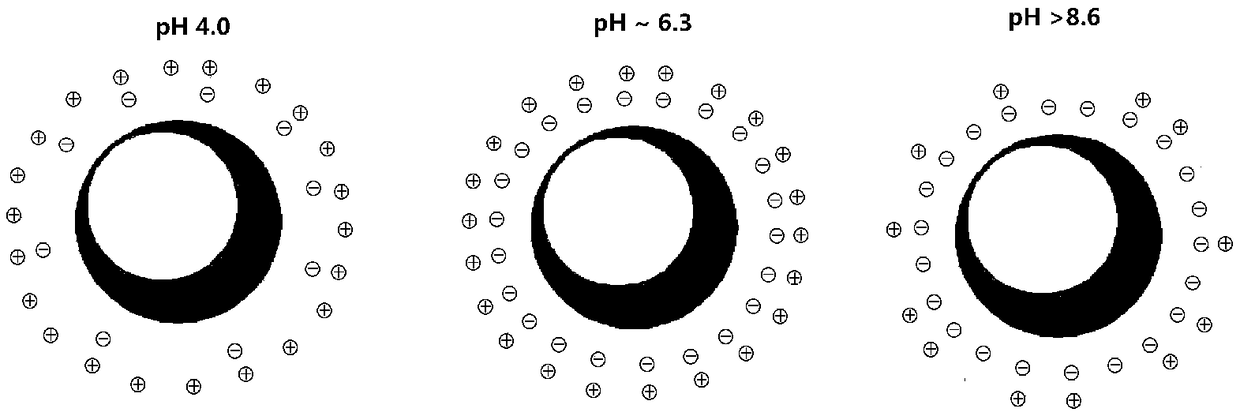Amphoteric dissociation ion exchange medium, application method and separation capacity calibration method
An ion exchange and separation medium technology, applied in the field of amphoteric dissociation ion exchange medium, to achieve the effect of high separation capacity, avoiding subsequent problems and high separation capacity
- Summary
- Abstract
- Description
- Claims
- Application Information
AI Technical Summary
Problems solved by technology
Method used
Image
Examples
Embodiment 1
[0112] Example 1: Preparation of representative structural forms of amphoteric dissociative ion exchange separation media
[0113] In the first step, prepare the following solution (filter with a 0.22um filter membrane to sterilize at the same time):
[0114] (1) Lysine solution: 100mM lysine was adjusted to pH 6.0 with 50mM hydrochloric acid, diluted with water to 30mM, and filtered for later use;
[0115] (2) Histidine solution: 50mM histidine solution, adjusted to pH 6.0 with 10mM hydrochloric acid, diluted to 30mM;
[0116] (3) Glycine solution: 100mM glycine solution was adjusted to pH 6.0 with dilute sodium bicarbonate, diluted with water to 30mM, and filtered for later use;
[0117] (4) N,N-dimethylethylenediamine solution: 10mM N,N-dimethylethylenediamine was adjusted to pH 6.0 with 0.10m hydrochloric acid, diluted to 10mM;
[0118] (5) Cysteine solution: 50mM cysteine aqueous solution, adjusted to pH 6.0 with 10mM sodium bicarbonate, diluted to 10mM, filtered fo...
Embodiment 2
[0137] Example 2: The operation process for measuring the adsorption and separation capacity of amphoteric dissociation ion exchange medium for acid red 13
[0138] The first step is to measure the influence of pH on the extinction coefficient of acid red 13; the results are shown in Figure 5 . The extinction coefficient of acid red 13 has no change between pH 4.0 and 8.9, both are 18.0 (mM) -1 .cm -1 ; The following acid red 13 all use this extinction coefficient.
[0139] In the second step, the amphoteric dissociation ion exchange separation medium is resuspended in the buffer solution with pH 3.6 for 3 times;
[0140] The third step is to dilute Acid Red 13 with adsorption buffer to not less than 5.0mM;
[0141] Step 4: Take the required amount of ion-exchange separation medium, remove the water phase, resuspend in 0.80ml of adsorption buffer, add diluted acid red 13 solution not exceeding 50μl to the required final concentration, and continue to mix gently at room te...
Embodiment 3
[0145] Example 3. The influence of adsorption and elution conditions on the separation capacity of the amphoteric dissociation separation medium (operate according to Example 2).
[0146] The first step is to adsorb at pH 3.6, and Acid Red 13 is 60M. See Table 1 for the pH effect of the eluent.
[0147] The pH of the eluent from 8.0 to 8.9 only has a strong impact on the capacity of FBD-MSP-ZEWC and FBD-MSP-ZEW3 to separate Acid Red 13, but it does not increase significantly after pH>8.9; if not stated below, For adsorbed acid red 13 or nucleic acid, use pH 8.9 eluent. The amount of acid red 13 before adsorption is taken as the total amount; under the washing conditions used, the proportion of acid red 13 in the washing liquid and the washing loss rate are lower than 2%. The reduction of Acid Red 13 in the above supernatant is the total amount of adsorption, and the elution rate of Acid Red 13 adsorbed on the representative amphoteric dissociation ion-exchange magnetic beads ...
PUM
| Property | Measurement | Unit |
|---|---|---|
| molecular weight | aaaaa | aaaaa |
Abstract
Description
Claims
Application Information
 Login to View More
Login to View More - R&D
- Intellectual Property
- Life Sciences
- Materials
- Tech Scout
- Unparalleled Data Quality
- Higher Quality Content
- 60% Fewer Hallucinations
Browse by: Latest US Patents, China's latest patents, Technical Efficacy Thesaurus, Application Domain, Technology Topic, Popular Technical Reports.
© 2025 PatSnap. All rights reserved.Legal|Privacy policy|Modern Slavery Act Transparency Statement|Sitemap|About US| Contact US: help@patsnap.com



